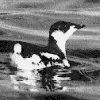 MARBLED
MURRELET RESEARCH AND POPULATION ESTIMATES MARBLED
MURRELET RESEARCH AND POPULATION ESTIMATES
The Marbled Murrelet is a secretive bird and little was known about
its population size or biology in B.C. prior to the 1990s. Since the
publication of the 1994 Marbled Murrelet Recovery Plan there has been
considerable effort directed towards Marbled Murrelet research in
British Columbia. A key role for the Recovery Team is to evaluate
the science and thus provide advice to decision-makers regarding conservation
and management strategies. Some current research topics and findings
are included below in the population estimates
and research sections. A detailed scientific
review of Marbled Murrelet research within B.C. is available as a
Canadian Wildlife Service Technical Report.
Marbled Murrelet Population Estimates
Estimating the number of Marbled Murrelets in B.C. has been difficult
because, unlike most other seabirds, Marbled Murrelets do not nest
in a few large colonies. Instead, the birds nest solitarily over much
of the B.C. coast and do not congregate in large numbers at any time
of year. Marbled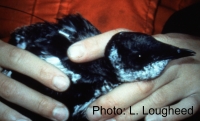 Murrelets are currently estimated to number roughly 55,000 to 78,000
in British Columbia. That population estimate is based on radar
surveys and at-sea surveys. Inventory
methods have been standardized by the Resources Information Standards
Committee (formerly Resources Inventory Committee) and are available
on-line.
Survey methods are outlined below:
Murrelets are currently estimated to number roughly 55,000 to 78,000
in British Columbia. That population estimate is based on radar
surveys and at-sea surveys. Inventory
methods have been standardized by the Resources Information Standards
Committee (formerly Resources Inventory Committee) and are available
on-line.
Survey methods are outlined below:
- Radar surveys: One method used to
count Marbled Murrelets in specific watersheds is radar surveys.
Radar is a tool for locating objects using high frequency radio
waves. Radio waves are emitted by the radar device and when they
hit an object they bounce back. By detecting returned signals the
radar unit can identify the location of objects. Marbled Murrelet
researchers use radar to detect Marbled Murrelets flying in and
out of coastal inlets. Radar surveys are conducted in the two hours
before dawn and the first hour after dawn, when the birds are flying
to and from their nesting areas. Crews deploy radar either from
an anchored boat or on land at the mouth of a coastal inlet. Murrelets
can be distinguished from other birds because they fly faster than
other birds and they commute from their feeding to nesting areas
in a straight line. Radar surveys have been conducted in the Clayoquot
Sound region, the Sunshine Coast, the Central Mainland coast, the
north coast, and the northwest coast of Vancouver Island. An important
result from the Clayoquot study is that radar counts at 18 watersheds
were significantly correlated with total watershed area, areas of
mature (> 140 yrs. old) forest and, most strongly, with areas
of mature forest below 600m. With the removal of old growth forests,
murrelets evidently moved elsewhere and did not pack into the remaining
old growth patches at higher densities.
- At-sea surveys: The purpose of at-sea
surveys is to count Marbled Murrelets on coastal waters where they
feed. Boats follow pre-set routes called transects and trained observers
count Marbled Murrelets within a fixed distance of the boat (often
50 m). The transects are usually 5-10 km long and run parallel to
the shoreline. Transects are set at fixed distances from the shoreline
and are commonly done 200 and 600 m out from the surfline.
Marbled Murrelet Research
Major focuses of Marbled Murrelet research in B.C. have concentrated
on locating nesting sites, and on Marbled Murrelet
ecology and demography. 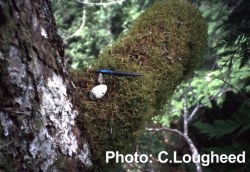
Nesting Site Research
Marbled Murrelet nests are very difficult to find. The first nest
was not found in B.C. until 1990. Researchers have now found about
200 Marbled Murrelet nests, more than half of which are in British
Columbia. Most nests in B.C. 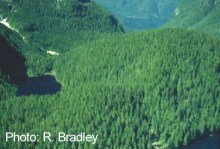 have
been found on large, moss-covered branches (15-75 cm diameter) of
large, old-growth conifer trees. A couple of nests have been found
on cliff ledges and one has been found in a deciduous tree. Marbled
Murrelets are poor fliers who do not build nests. They fly into an
opening in a forest canopy and stall-land on a wide, mossy bough with
overhead foliage that provides cover. The bough must be high enough
for them to jump off and start flying from a free-fall. have
been found on large, moss-covered branches (15-75 cm diameter) of
large, old-growth conifer trees. A couple of nests have been found
on cliff ledges and one has been found in a deciduous tree. Marbled
Murrelets are poor fliers who do not build nests. They fly into an
opening in a forest canopy and stall-land on a wide, mossy bough with
overhead foliage that provides cover. The bough must be high enough
for them to jump off and start flying from a free-fall.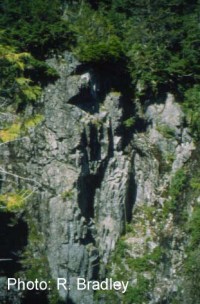 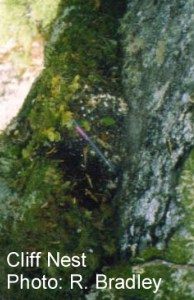
Terrestrial Surveys
Nests or nesting areas have been found by surveying areas of forest
suspected to have nesting birds. Several different survey methods
have been used including:
- Occupied detections: Looking and listening for adult murrelets
to determine occupied detections. An occupied detection is when
Marbled Murrelets are seen or heard landing on branches, perching
or flying below, through or out of the forest canopy. Although the
actual nests are not found using this method, occupied detections
provide an indicator of the types of habitats used by Marbled Murrelets.
Map of occupied detections survey locations in
B.C. (from SFU group)
- Tree climbing: Forest areas are surveyed for trees that are suitable
for Marbled Murrelet nests and then trees are climbed by professionals
to determine if nests are present. Comparisons between different
types of habitat have been conducted by selecting plots at random
within each habitat type followed by a search for nests using tree
climbing.
- Following flight paths: Marbled Murrelets are observed on successive
days whilst they fly into particular areas. Researchers ‘home
in on’ the nest by observing murrelets on their specific flight
paths to and from the nest. Every day they get closer and closer
to the nest until they observe a bird at the nest.
- Nesting evidence: Researchers search the forest floor for signs
of nests such as egg shells fragments or chicks that have fallen
out of nests and perished.
Radio Telemetry
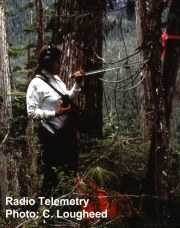 Radio
Telemetry has also been used to track Marbled Murrelets to nesting
locations. Birds are captured at sea at night using a bright light
and dip-net. A small transmitter that emits radio waves at a preset
frequency is attached to birds caught at sea. Each transmitter emits
radio waves at a separate frequency which allows the identification
of individual birds. Researchers use a helicopter and a radio receiver
to determine the direction from which the signal is strongest. Once
the general area of the nest is located, a ground crew is deployed
to help pin point the actual nesting tree. Telemetry has been successfully
used to locate nests in Desolation Sound, Clayoquot Sound and in Mussel
Inlet. (More information about this project can be found at the Centre
for Wildlife Ecology website.) Radio
Telemetry has also been used to track Marbled Murrelets to nesting
locations. Birds are captured at sea at night using a bright light
and dip-net. A small transmitter that emits radio waves at a preset
frequency is attached to birds caught at sea. Each transmitter emits
radio waves at a separate frequency which allows the identification
of individual birds. Researchers use a helicopter and a radio receiver
to determine the direction from which the signal is strongest. Once
the general area of the nest is located, a ground crew is deployed
to help pin point the actual nesting tree. Telemetry has been successfully
used to locate nests in Desolation Sound, Clayoquot Sound and in Mussel
Inlet. (More information about this project can be found at the Centre
for Wildlife Ecology website.)
Field data on nest site characteristics have been used to develop
models that facilitate the prediction of suitable nesting habitat
for Marbled Murrelets based on information obtained from habitat maps.
There are several models for murrelet nesting habitat evaluation currently
under development for different parts of the coast in British Columbia.
(Note that the Pacific Seabird Group established a Marbled
Murrelet Technical Committee in 1986 to assemble researchers and
other interested parties to integrate research objectives and methods,
and share information on the biology of murrelets).
Marbled Murelet Ecology and Demography
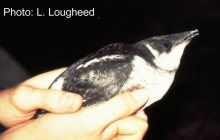 In
order to understand why a population of animals is increasing or decreasing,
the death rate, birth rate, age at first breeding and fecundity must
be known. Death rates and birth rates can be affected by many factors.
Factors that may affect death rates include: food availability, predation,
disease and oil spills. The study of factors that affect population
change is called demography. In
order to understand why a population of animals is increasing or decreasing,
the death rate, birth rate, age at first breeding and fecundity must
be known. Death rates and birth rates can be affected by many factors.
Factors that may affect death rates include: food availability, predation,
disease and oil spills. The study of factors that affect population
change is called demography.
Some ecological and demographic findings by the CWE (Centre for Wildlife
Ecology at Simon Fraser University) and their partners at Desolation
Sound, B.C. include:
- Fecundity estimate for Marbled Murrelets: .15 - .22. Fecundity
is the number of fledged females produced per adult female per year.
- Marbled Murrelets can live to at least 9 years
- Annual adult survival estimate for 1991-2000 is 0.83 (0.72-0.90,
95% confidence interval)
- A two year old Marbled Murrelet was discovered with a brood patch,
indicating that they may breed as early as two.
|

 MARBLED
MURRELET RESEARCH AND POPULATION ESTIMATES
MARBLED
MURRELET RESEARCH AND POPULATION ESTIMATES
 Murrelets are currently estimated to number roughly 55,000 to 78,000
in British Columbia. That population estimate is based on
Murrelets are currently estimated to number roughly 55,000 to 78,000
in British Columbia. That population estimate is based on 
 have
been found on large, moss-covered branches (15-75 cm diameter) of
large, old-growth conifer trees. A couple of nests have been found
on cliff ledges and one has been found in a deciduous tree. Marbled
Murrelets are poor fliers who do not build nests. They fly into an
opening in a forest canopy and stall-land on a wide, mossy bough with
overhead foliage that provides cover. The bough must be high enough
for them to jump off and start flying from a free-fall.
have
been found on large, moss-covered branches (15-75 cm diameter) of
large, old-growth conifer trees. A couple of nests have been found
on cliff ledges and one has been found in a deciduous tree. Marbled
Murrelets are poor fliers who do not build nests. They fly into an
opening in a forest canopy and stall-land on a wide, mossy bough with
overhead foliage that provides cover. The bough must be high enough
for them to jump off and start flying from a free-fall.

 Radio
Telemetry has also been used to track Marbled Murrelets to nesting
locations. Birds are captured at sea at night using a bright light
and dip-net. A small transmitter that emits radio waves at a preset
frequency is attached to birds caught at sea. Each transmitter emits
radio waves at a separate frequency which allows the identification
of individual birds. Researchers use a helicopter and a radio receiver
to determine the direction from which the signal is strongest. Once
the general area of the nest is located, a ground crew is deployed
to help pin point the actual nesting tree. Telemetry has been successfully
used to locate nests in Desolation Sound, Clayoquot Sound and in Mussel
Inlet. (More information about this project can be found at the
Radio
Telemetry has also been used to track Marbled Murrelets to nesting
locations. Birds are captured at sea at night using a bright light
and dip-net. A small transmitter that emits radio waves at a preset
frequency is attached to birds caught at sea. Each transmitter emits
radio waves at a separate frequency which allows the identification
of individual birds. Researchers use a helicopter and a radio receiver
to determine the direction from which the signal is strongest. Once
the general area of the nest is located, a ground crew is deployed
to help pin point the actual nesting tree. Telemetry has been successfully
used to locate nests in Desolation Sound, Clayoquot Sound and in Mussel
Inlet. (More information about this project can be found at the  In
order to understand why a population of animals is increasing or decreasing,
the death rate, birth rate, age at first breeding and fecundity must
be known. Death rates and birth rates can be affected by many factors.
Factors that may affect death rates include: food availability, predation,
disease and oil spills. The study of factors that affect population
change is called demography.
In
order to understand why a population of animals is increasing or decreasing,
the death rate, birth rate, age at first breeding and fecundity must
be known. Death rates and birth rates can be affected by many factors.
Factors that may affect death rates include: food availability, predation,
disease and oil spills. The study of factors that affect population
change is called demography.